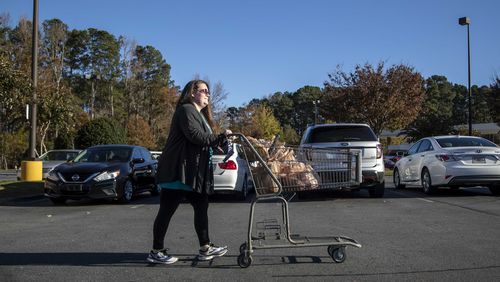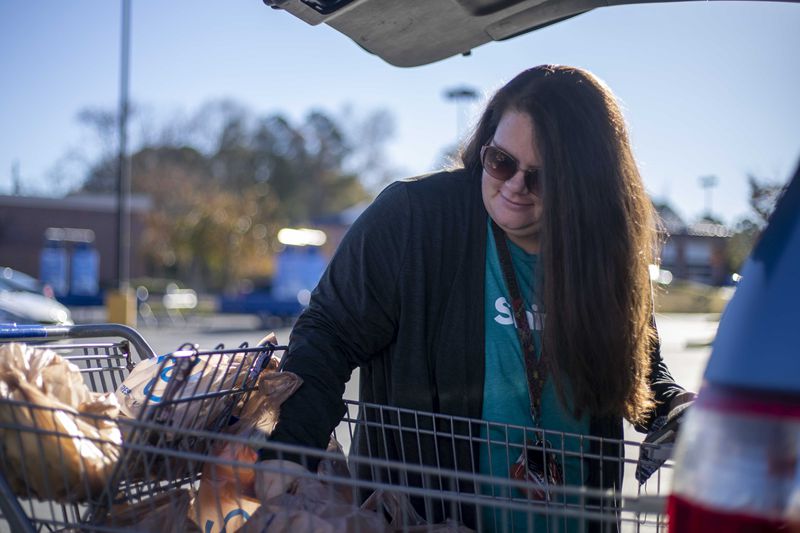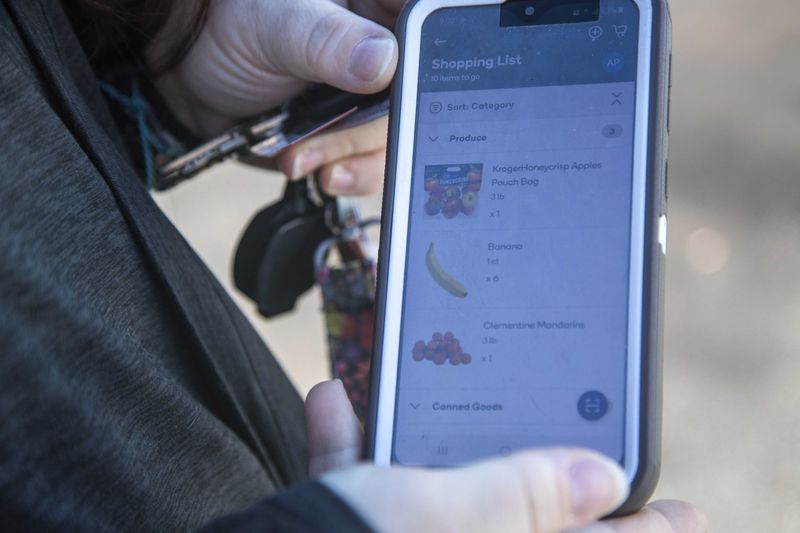April Wright had been a professional grocery shopper for more than two years when the coronavirus pandemic hit.
It didn’t take long for her to notice a difference in the size of the orders that Shipt, the shopping and delivery company she works for, started receiving.
“I had an influx of bigger orders for basic necessities — meats, pasta, your TP, your cleaners,” said the Canton woman, who juggles shopping trips with being mom to her five boys.
Her customers also wanted more comfort foods and snacks. And some asked if she could shop for games and toys for children stranded at home while she was picking up groceries at Target.
Credit: Alyssa Pointer / Alyssa.Pointer@ajc.com
Credit: Alyssa Pointer / Alyssa.Pointer@ajc.com
Recent numbers show the pandemic pushed online grocery sales in the U.S. to extraordinary heights. In August 2019, sales were $1.2 billion, according to data gathered by the companies Brick Meets Click and Mercatus. In June 2020, they were $7.2 billion.
Meanwhile, online sales grew from 3.4% of the grocery buying market in 2019 to 10.2% a year later, according to Mercatus and consumer data firm Incisiv.
The change is creating thousands of new jobs in Atlanta, from high-tech positions to warehouse and delivery workers.
Online shoppers will see improved delivery services and a better online user experience as companies compete for their share of the $1 trillion annual U.S. grocery market, industry analyst David J. Livingston said. But some smaller grocers likely won’t be able to keep up and could end up closing as behemoths like Walmart and Amazon continue to take bigger chunks of the online grocery business.
Grocery store chains are staying competitive by throwing more resources into the fight. Kroger, for instance, has hired the British company Ocado to build a $55 million warehouse in Forest Park where robots will help sort online grocery orders. The chain will begin delivering in the metro area in 2021.
“We’ll all look back on this year as being possibly the most significant inflection point for online grocery shopping,” said David Hardiman-Evans, Ocado’s senior vice president for North America.
The tipping point
Two decades ago, Webvan was one of the first companies to try to build a national online grocery shopping and delivery empire in Atlanta and nine other cities. But it failed to attract enough customers to support its expensive infrastructure, which included warehouses, delivery trucks and vans and about 2,000 full-time employees.
After that, various companies pieced together a workable system. Grocery chains created their own shopping web pages and some included delivery, while independent gig companies like Shipt and Instacart also popped up to offer delivery. Stores also began allowing customers to order online then pick up their bagged items.
Credit: Alyssa Pointer / Alyssa.Pointer@ajc.com
Credit: Alyssa Pointer / Alyssa.Pointer@ajc.com
During August 2019, 16.1 million people shopped for groceries online, according to the Brick Meets Click/Mercatus survey. In June 2020, the number jumped to 45.6 million.
By September of this year, as many as six-in-10 shoppers said they had made online grocery purchases, according to sales and marketing agency Acosta. That is up from the two-in-10 that said they had in a 2019 Gallup poll.
Groceries were slower to take off as online purchases than other goods. Unlike a pair of Levi’s, one steak is not like another.
“Lots of customers want to pick out their own meat and produce,” Hardiman-Evans said.
Customers like James D. Brown.
“I believe I can pick the freshest and most recent items by seeing it for myself,” Brown, 68, said outside a Vinings grocery store.
His wife tried online shopping and was disappointed in the results. She returned to in-store shopping.
Other long-time shoppers had good experiences, but have other concerns.
“It’s more expensive. But, for convenience sake, I continue to use it,” said Christine Munzert, 55.
She and her sister, Deanna Munzert, 58, have been buying some of their groceries online for more than a year. On top of the delivery fees, customers are expected to tip their shoppers for hire.
Shop-and-delivery fees vary by time of day, speed of service and company. They range $3.99 for an order worth more than $35 from Instacart, for example, to Walmart’s $7.95 single delivery fee, with a $10 charge for expedited delivery. However, the competition is driving the companies to give special offers, including single-fee monthly rates.
The future is here to stay
Though online sales began tapering off in August as lockdowns and restrictions disappeared, many analysts believe sales will stay above pre-pandemic levels and continue to grow.
Bill Bishop, a co-founder of Brick Meets Click, said some of those who tried online grocery shopping for the first time will appreciate the ease of it and will stick with it. Others will continue to use it occasionally.
The shift and competition for online customers is reshaping the business landscape in metro Atlanta and the U.S.
Shipt is bringing on board 3,000 more delivery workers in Georgia between now and Christmas, part of a nationwide push to expand by 100,000. Instacart, the other big player among independent shop-and-deliver companies, has added 300,000 since March across the U.S. The new Kroger warehouse will employ 400 new workers
The competition for customers will make the strong companies better and sort out the weak ones, said Livingston.
“Unless a small independent has a compelling reason to attract consumers, such as signature items only sold at their store, I see most going away,” he said.
The robotic Kroger warehouse is the next step in that evolution of competition, Hardiman-Evans said. It’s unlikely the massive warehouse will run out of a product, as a local grocer might, and artificial intelligence will keep errors to a minimum.
Other vendors are considering opening micro-fulfillment centers in locations such as shuttered stores so that they can be closer to consumers and offer quicker delivery.
“Even if COVID disappears, consumers have already changed the way they shop,” Livingston said. “It’s unlikely they will go backwards after having a taste of online shopping.”
Online grocery sales in the U.S.*
August 2019: $1.2 billion
March 2020: $4 billion
April 2020: $5.3 billion
May 2020: $6.6 billion
June 2020: $7.2 billion
July 2020: $5.7 billion
*Courtesy of Brick Meets Click/Mercatus
About the Author










